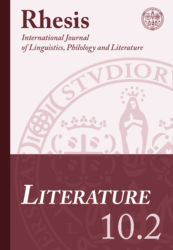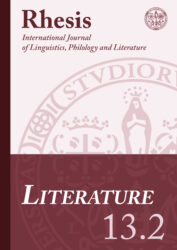 LiteratureVol. 10.2 - 2019
LiteratureVol. 10.2 - 2019Table of contents
| p. 5 | The Bildungsroman and class consciousness: the role of shame in Kipps by H.G. WellsClaudia Cao Abstract Kipps (1905) by Herbert George Wells establishes an ambiguous relationship with the nineteenth-century Bildungsroman: by parodying it and by caricaturing its archetypical characters, Wells’s work lays bare the values and cultural background on which the nineteenth-century production of the genre was based. In particular, given the focal role of the social compromise between bourgeoisie and aristocracy in this production, Wells’s novel has the effect of showing the weakening of the upper class as well as illustrating a transition phase of the middle class which had not yet been legitimised to constitute a new social model. |
| p. 19 | Not Every Woman is an Island: Some Notes about Isles of Women and Colonisation in the OdysseyMorena Deriu Abstract Comparing some characteristics of Archaic Greek colonisation and modern colonialism, the paper reads the Odyssean motif of the isle of women, the woman/island pair, and the related erotic imagery as the results of an interaction between historical events and literary imagination. Indeed, besides being commonly found in ancient mythologies, isles of women are generally considered as the mythic precursors of the vision that sees settlement of a new land as the conquest of a woman. Since the binarism and strong sense of a superior centre common to the colonisation of the New World and colonialism do not seem appropriate to Archaic Greece, the peculiarities of the ancient and modern erotic imageries related to the arrival of a seafarer in a new land and the woman/island pair can be understood by considering the differences between modern Western colonialism and the Archaic Greek decentred attitude to place, religion, and ethnicity. |
| p. 33 | A possible deliberate Mahābhārata-echo in the imagery of the Buddhacarita compounded-rūpakasDiletta Falqui Abstract The main focus of the paper is to tentatively document traces of hypertextuality between the Buddhacarita and the Mahābhārata, under the assumption that Aśvaghoṣa probably knew this latter work, albeit non-definitive version of it. The selected methodological approach is a comparison between Bc and MBh in-compound-rūpakas. Indeed, since it is plausible that he benefited from an erudite court audience, Aśvaghoṣa is here assumed to take for granted that even indirect hints at MBh passages would be promptly understood. Therefore, he sometimes re-uses Mahābhārata expressions, and merely changes the word-order or replaces a single constituent in the matching figurative phrases or compounds, and sometimes plays with the MBh rūpakas in a more complex way. |
| p. 56 | Il paesaggio segreto nella narrativa di Simona VinciIrene Palladini Abstract The present research aims to analyse the perceptive and representative modalities of landscape in the narrative production of Simona Vinci. Through the framing of a particular anthropology of the eye, connected to a corporal rendition of places, the writer creates a deep mindscape, rich in fairy refractions and an oneiric amplitude. But, above all, in her narrative production, it is fear the orbit to which Vinci’s landscapes can be ascribed: therefore, the expression fearscape can be introduced in order to understand the force of a writing which is characterized by an urgent need. |
| p. 68 | Qurratulain Hyder tra auto-traduzione e riscrittura: il caso di HonourValerio Pietrangelo Abstract Some scholars, including Grutman (20092) and Popovič (1975), believe that self-translation of literary works should be defined essentially as translation, whereas others recognize that works translated by their authors have their own specificities and cannot be described as the mere output of translating. The Indian writer Qurratulain Hyder is among the famous authors who wrote their literary works in two different languages, in this case Urdu and English. The novel Āg kā dariyā, allegedly her masterpiece, written in 1959, was transcreated in English in 1998. A comparison of the two versions shows notable differences and sheds light on the peculiarities of creative writing in English and in Urdu in the Indian Subcontinent. Āg kā dariyā, however, is not the only example of rewriting by Qurratulain Hyder. Among her other works, the short story Ḥasab nasab, rewritten in English as Honour, shows some similarities with Āg kā dariyā. Our conclusion is that self-translation may be considered as a rewriting, and possibly a new original. The article is followed by the translation into Italian of both the Urdu and English versions. |
| p. 91 | The poetical strategy of Aśvaghoṣa: the Brahmanical image of phena ‘foam’ in a doctrinally inspired Buddhist poetryPaola M. Rossi Abstract This article aims to explore the new poetical strategy devised by the famous poet Aśvaghoṣa (2nd CE), a Brahmin converted to Buddhism, in order to promote the Buddhist doctrine: his works represent that cultural syncretism, which was supported by the policy of the Kuṣāṇa dynasty, spanning over three centuries in the northern India. Such a cultural environment stimulated new communicative strategies, especially on occasion of doctrinal debates, which must be held between the promoters of the Brahmanical counter-reformation movement, developed since the last centuries BCE – as assumable from the Brahmanical epics, especially the Mahābhārata –, and the challenging innovative Buddhist currents, such as the (Mūla)Sarvāstivāda school, attested in the Mathurā region, with which also Aśvaghoṣa must be affiliated. Against such a cultural background, the learned Aśvaghoṣa elaborated a sophisticated poetics, consisting not only of mere ornamentation, according to the earlier kāvya models, represented by the Brahmanical Rāmāyaṇa, but also of deeply complex inter-textual connections, made of flowing analogical suggestions, even inconsistent, producing a sort of ‘multistable’ perception of reality. Thus, an innovative kāvya poetry was shaped, fascinating and disorienting the educated audience at the same time. In fact, the manifold layers of reality, resulting from multi-meaning poetic expressions, suggest the main Buddhist principle which is exactly counterposed to the Brahmanical ontology: the phenomenal existence is devoid of a unique ‘essence’ itself (ātman), and is therefore ultimately unsubstantial. |
| p. 112 | Lotta sociale e spazio urbano: In the Cage, Henry JamesSilvia Silvestri Abstract The paper aims to explore the interplay between class conflict and urban milieu that structures In the Cage’s narrative. Starting from the author’s prefaces and some of the most influential sociological essays of the time, this study delves into the spatial counterpoints – streets, houses, parks, neighbourhoods – used by James to represent the social turmoil that upsets Late Victorian London, thus giving shape to the emerging classes’ difficulty in creeping into its hermetic class system. In the nouvelle, such a predicament is effectively thematized by the experiences of an anonymous telegraphist, whose burning desire for social improvement translates into the attempt to physically penetrate and “colonize” the most aristocratic areas of London. As the paper demonstrates, her efforts are met with utter disappointment: she always feels like an intruder in Mayfair’s posh streets, and she ends up seeing nothing but the hall of Park Chambers apartments. Constantly pushed to the city margins, she can only gain access to Maida Vale – the suburban limbo where her friend Mrs. Jordan lives – and Chalk Farm, which by virtue of its position «near town, and at the same time quite secluded» (Walford 1878) functions as a perfect spatial correlative to her liminal social status. |
| p. 123 | Osbern Bokenham’s Life of Seynt Poule the First Heremyte: Authority, Community and LocationAlice Spencer Abstract The present paper will represent the first extended study of the verse Life of St. Paul the First Hermit included in the Abbotsford Legenda Aurea. The Abbotsford Legenda Aurea is an as yet unpublished manuscript containing the only surviving copy of the translation of the Legenda Aurea by the fifteenth-century East Anglian Austin friar, Osbern Bokenham. The Life of Saint Paul the First Hermit is of particular interest since it is one of only three extant verse lives of male saints by Bokenham, who, prior to the discovery of the Abbotsford MS, was considered primarily as an author of lives of female saints. Rather than basing his text of Paul’s life on that in Voragine’s Legenda, Bokenham translates directly from Voragine’s source, the significantly longer vita by Jerome. The descriptions of Paul’s cave, of the monsters who Anthony meets in the desert and of the warm relationship which develops between Anthony and Paul had all been significantly cut back in Voragine’s text and Bokenham’s choice of source is indicative of the crucial thematic importance of these episodes to his retelling, which has a Preface in Chaucerian rime royal and is replete with stylistic and verbal echoes of his more secular vernacular forebears. In emphasising the familial ties binding the monastic brotherhood through his depiction of Paul, Anthony and Anthony’s disciples, Bokenham affiliates his own hagiographic output to an ancient transhistorical community (Sanok 2007) which legitimizes his poetic voice without severing it outright from the secular vernacular traditions in which his style is rooted. |
| p. 138 | Olivier: la versione di LatoucheFabio Vasarri Abstract Olivier (1826) is Henri de Latouche’s contribution to the fictions of sexual impotence in the French Restoration. In this context, impotence frequently functions as a symptom of the crisis of the aristocracy in the modern world. This paper compares Latouche’s novel with similar texts authored by Claire de Duras and Stendhal, particularly focusing on the notion of masculinity, on the social and cultural aspects of romantic eros and on the role of the French Revolution in the plot. |
Tags: Abbotsford Legenda Aurea, Alice Spencer, Aśvaghoṣa, Augustinianism, Bildungsroman, body, Brahmanical epics, Buddhacarita, Buddhist poetics, class conflict, Claudia Cao, colonisation, Diletta Falqui, eye, Fabio Vasarri, fairytale, fear, H.G. Wells, hagiography, Henri de Latouche, Henry James, Herbert George Wells, Homer, hypertextuality, impotence, In the Cage, Irene Palladini, island, kāvya, Kipps, landscape, London, Mahābhārata, masculinity, Morena Deriu, Odyssey, Olivier, Osbern Bokenham, Paola M. Rossi, Qurratulain Hyder, rewriting, romantic eros, rūpaka, self-translation, shame, Silvia Silvestri, Simona Vinci, St. Paul of Thebes, topos woman-river, translation, urban milieu, Urdu literature, Valerio Pietrangelo, women

